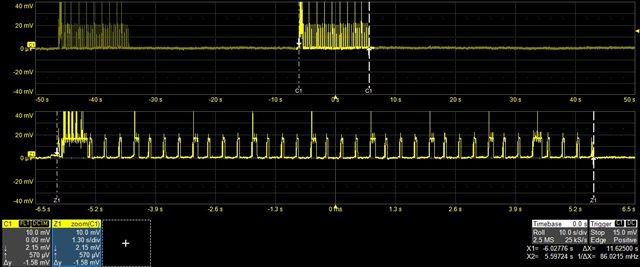Hello,
I'm doing a comparison between MQTT on TCP and CoAP on UDP over NB-IoT and LTE-M. The communication to the cloud works as expected for both protocols. MQTT is used with TLS and Coap is used with DTLS.
Now the next step is to get an impression of the power consumption for both protocols in certain scenarios. But what I saw on the oszilloscope is not what I expected (see screenshot below). Every time I transmitted a packet to the cloud it took more than 10s until the modem went into the sleep mode again. But the response to a request packet has been received much earlier in case a response was expected.
What I can see in the LTE Link Monitor is that the modem outputs "+CSCON: 1" every time the high power consumption time starts and it outputs "+CSCON: 0" every time it goes into the sleep mode again (after more than 10s).
The picture below shows a screenshot of the MQTT communication but the same applies to CoAP.

For the test in the picture above I used PSM mode with the following configuration (eDRX has been deactivated)
- CONFIG_LTE_PSM_REQ_RPTAU = 1h
- CONFIG_LTE_PSM_REQ_RAT = 3s
From what I read in this post the reason for this behavior is that the modem is still in RRC_CONNECTED for a serveral seconds although the communication has already been finished.
https://devzone.nordicsemi.com/f/nordic-q-a/81278/early-release-assistance-indication
My questions are now:
- Produces the missing Release Assistance Indication the behavior I discovered in my description above?
- If yes, how can I solve the problem to get a much lower power consumption?
- How can I enable the Release Assistance Indication in combination with TLS for MQTT and DTLS for CoAP on the nRF Connect SDK? I know there is an ICMP example (see link below) but I couldn't find "SO_RAI_ONE_RESP" in the SDK. Furthermore as described above I need a solution for TLS and DTLS.
For my tests I used the following setup:
- nrf9160 DK revision 1.1.0
- ncs v2.0.0
- modem firmware is mfw_nrf9160_1.3.2
- MNO is Deutsche Telekom
Thanks in advance.
Best regards,
Christian


